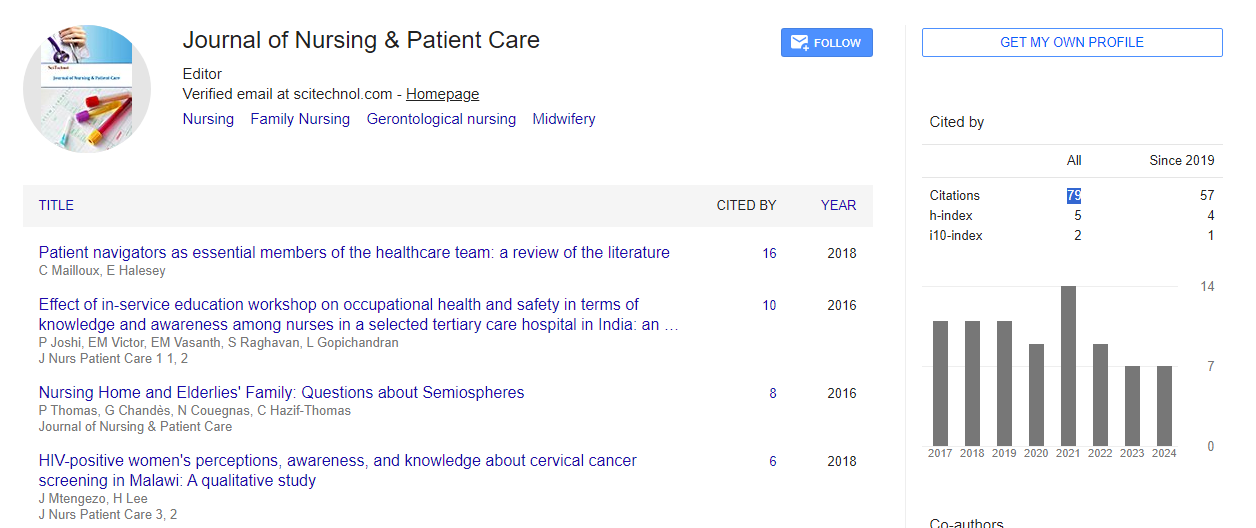Perspective, J Nurs Patient Care Vol: 9 Issue: 4
Impact of Preventive Nursing Care on Reducing Hospital Readmissions and Promoting Sustainable Health Outcomes
Ping Wei*
1Department of Nursing, Wenzhou Medical University, Wenzhou, China
*Corresponding Author: Ping Wei,
Department of Nursing, Wenzhou Medical
University, Wenzhou, China
E-mail: weipi@ng.edu.cn
Received date: 23 November, 2024, Manuscript No. JNPC-24-155461;
Editor assigned date: 25 November, 2024, PreQC No. JNPC-24-155461 (PQ);
Reviewed date: 09 December, 2024, QC No. JNPC-24-155461;
Revised date: 17 December, 2024, Manuscript No. JNPC-24-155461 (R);
Published date: 24 December, 2024, DOI: 10.4172/2573-4571.1000082.
Citation: Wei P (2024) Impact of Preventive Nursing Care on Reducing Hospital Readmissions and Promoting Sustainable Health Outcomes. J Nurs Patient Care 9:4.
Description
Preventive nursing care is at the focus of modern healthcare, emphasizing proactive measures to illnesses, manage chronic conditions and reduce hospital readmissions. By focusing on prevention rather than treatment, nurses play a essential role in promoting sustainable health outcomes and enhancing the quality of life for patients. This approach is critical in addressing the growing challenges of healthcare systems, including rising costs, overburdened facilities and the prevalence of preventable diseases. Hospital readmissions are a significant concern for healthcare providers and patients alike. High readmission rates not only indicate potential gaps in care but also place financial and emotional burdens on patients and their families. Preventive nursing care addresses this issue by implementing evidence based strategies that focus on patient education, early detection and effective management of health conditions. Nurses, as primary caregivers are uniquely positioned to identify risk factors for readmission and intervene before complications arise.
One of the primary strategies in preventive nursing care is patient education, which equips individuals with the knowledge and skills needed to manage their health. For example, patients with chronic diseases such as diabetes or heart failure benefit greatly from education programs that teach them how to monitor their symptoms adhere to prescribed medications and maintain a healthy lifestyle. Nurses provide clear instructions, practical demonstrations and supportive follow-ups to ensure patients are confident in managing their care after discharge. This proactive approach reduces the likelihood of complications that often lead to readmissions. Preventive nursing care also emphasizes early detection of potential health issues. Nurses conduct thorough assessments during and after a patient’s hospital stay, identifying warning signs that may indicate deterioration in health. For instance, monitoring vital signs, wound healing or respiratory function enables nurses to detect subtle changes that require medical attention. Care coordination is another component of preventive nursing care. Hospital discharge can be a weak time for patients, as the transition from a structured medical environment to self-care at home often presents challenges. Nurses play a important role in ensuring continuity of care by coordinating with multidisciplinary teams, arranging follow-up appointments and facilitating access to community resources. This seamless transition reduces the risk of readmission by ensuring that patients receive the support they need to recover successfully.
In addition to individual patient care, preventive nursing practices extend to public health initiatives that target broader populations. Community health programs led by nurses focus on vaccination campaigns, screenings for chronic diseases and health promotion activities. By addressing risk factors at the population level, these programs reduce the incidence of preventable illnesses and the subsequent strain on healthcare facilities. Technology has become an important tool in enhancing preventive nursing care. Telehealth platforms allow nurses to monitor patients remotely, providing timely interventions without the need for hospital visits. Wearable devices that track vital signs and activity levels enable continuous monitoring of at-risk patients, allowing nurses to identify and address potential problems early. These technological advancements not only reduce readmissions but also empower patients to take an active role in their health management. Challenges remain in fully integrating preventive nursing care into healthcare systems. Barriers such as limited staffing, insufficient training and lack of funding for preventive initiatives must be addressed to realize its full potential.
Conclusion
Preventive nursing care is a powerful strategy for reducing hospital readmissions and promoting sustainable health outcomes. By emphasizing patient education, early detection, care coordination and lifestyle interventions, nurses play a transformative role in shifting the focus from treatment to prevention. The integration of technology and community-based programs further enhances the effectiveness of preventive nursing care. As healthcare systems evolve to meet the demands of a changing world, preventive nursing will remain a cornerstone of patient-centered, cost-effective and sustainable care.
 Spanish
Spanish  Chinese
Chinese  Russian
Russian  German
German  French
French  Japanese
Japanese  Portuguese
Portuguese  Hindi
Hindi 